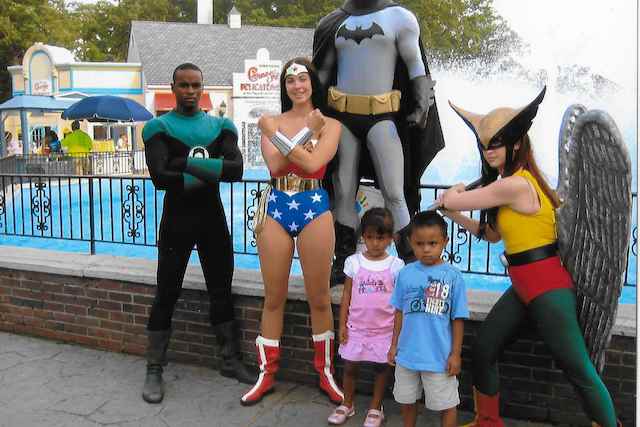 (Joshua Dela Cruz visits the Build Series to discuss the Nickelodeon live-action/animated interactive educational children’s television series “Blues Clues & You!” at Build Studio on November 06, 2019 in New York City. (Photo by Gary Gershoff/Getty Images))
(Joshua Dela Cruz visits the Build Series to discuss the Nickelodeon live-action/animated interactive educational children’s television series “Blues Clues & You!” at Build Studio on November 06, 2019 in New York City. (Photo by Gary Gershoff/Getty Images))
Before Josh bakes bibingka (a Filipino rice cake dessert) with his Lola, an endearing term for grandmother in the Philippines, he makes sure to greet her with a “mano po.” This gesture of respect, where you take an elder’s hand to your forehead, is one of many moments in Nick Jr.’s “Blue’s Clues & You!” that gives young Filipino-Americans the opportunity to see and celebrate themselves.
The show’s a spinoff of the original 1996 “Blue’s Clues” and features 32-year-old Filipino-American host Joshua Dela Cruz. It’s the first mainstream American children’s television show to spotlight Southeast Asian culture; it’s also one of many new shows that celebrate multiculturalism. In a recent episode, Josh sings a Tagalog version of “3 Little Ducks” with his Lola, encouraging viewers to join him in the bilingual sing-along.
This had me reflecting on my childhood experiences with media and my own Filipino culture. How different would my personal relationship to my heritage be if I had Josh’s colorful Tagalog tunes as a child?
I was raised in a Filipino immigrant household in New York City. For the longest time, I grew up feeling half immersed in my culture, knowing that I was unable to participate in what I view to be one of the most beautiful elements of it — the language. While I often spent weekends at “Little Manila” hubs across the five boroughs, constantly surrounded by “mano pos,” Filipino food, as well as Tagalog and Bisaya-speaking family members, I was never able to pick up on any of the Filipino dialects.
My parents immigrated from the Philippines in the ‘80s and ‘90s and raised my brother and me speaking English. According to them, it wasn’t really a conscious decision. Like so many other Filipino moms, mine spent evenings away at the hospital working night shifts as a registered nurse. My dad spent days working as a physical therapist assistant. This often left my brother and me alone with our TV after school, recycling our favorite DVDs and tuning into educational programming on stations like PBS Kids. I never really needed to use our language in practice, and to be honest, wasn’t interested in it as a kid.
In spite of the unusual language dynamics of my household, the words thrown across my living room have never eluded me. When my parents speak to each other or their friends in Tagalog or Bisaya, gears turn and my brain automatically translates the sentence into a somewhat clear English sentence. Though this intrinsic translation mechanism is not perfect, I can always understand the message. When I try to respond to them in the language, however, my brain is just a fuzzy void, and I am unable to find the right words to reply. This phenomenon of understanding a language but not being able to speak it is formally called receptive bilingualism. There is currently little research on it, but many first-generation children can attest to this (literally) unspoken, universal experience. I seem to understand Tagalog and Bisaya a lot more than my brother does, and we’re twins, with similar childhood experiences. Sometimes, I wonder if that can be attributed to my curious 8-year-old self wandering onto Filipino channels and teleserye shows. Today, I can still remember the lyrics of the Filipino theme song from the teleserye “Mutya,” the show that allowed me to pick up fragments of the language with the help of subtitles.

While I don’t expect Tagalog-fluent kids to emerge from “Blue’s Clues,” diversity in kids’ TV has psychologically beneficial outcomes for underrepresented children. I know that it certainly would’ve boosted my self-esteem as a little girl. Growing up, my family always felt pride in seeing ourselves on the screen. We still throw glances at each other after the smallest mention of the Philippines in a show or movie, though they are often stereotypical jokes.
Shows like “Blues Clues & You!” also allow children to look through a window (versus a mirror) and learn about the experiences of their peers. Moreover, studies have shown that multilingual exposure can scientifically benefit learning, even in monolingual households. Fragments of the childhood programming we watch as kids never truly leave us; they’re linked to our emotional development and play into our natural desire for nostalgia. Most of us can still recall the themes and plotlines from these memorable shows. Now, young children are engaging with even more media, and in different forms. When we diversify the narratives they see, we diversify that ingrained learning.

Hopefully, there’s more to come. In the meantime, I’m happy to know that somewhere, someone is a little more excited to greet their Lola with a “mano po.”